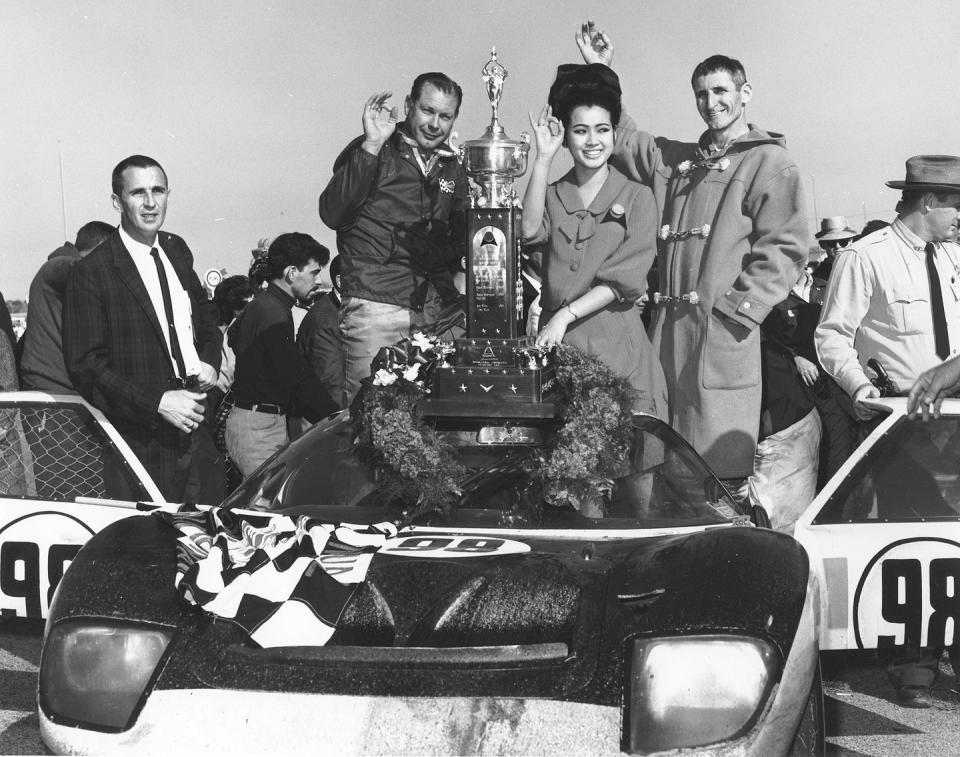The True Story of Ken Miles' Mysterious Death That 'Ford v. Ferrari' Left Out

“I’d rather die in a racing car than get eaten up by cancer," Ken Miles is quoted as saying in Go Like Hell: Ford, Ferrari, and Their Battle for Speed and Glory at Le Mans, which tells the same tale as told in the Oscar-nominated film Ford V Ferrari.
And, in the end, that’s how Ken Miles, who’s played by Christian Bale, does end up in that driver’s seat in the sky. He dies in a tragic crash at the end of the movie—after he’s cheated out of a first place win at Le Mans because of a botched PR plan. But there's much more to the real story of Miles' mysterious death than we see in the movie.
The story told in Ford v. Ferrari has become one of the great modern automotive yarns because it’s one of boardroom egos and corporate revenge. And with a nomination for Best Picture at the Academy Awards, Ford V Ferrari has inspired a new interest in this story. This is a narrative of space-race, moonshot-like ambition that was pervasive in 1960s America, except with cars. Ford was going to build a car to beat Ferrari in the world’s most important race, Le Mans—a race Ferrari had won five years in a row.
The story in a nutshell: Ferrari is set to be bought by Ford. The plan is rebuffed when the big boss Enzo Ferrari finds out that he’ll lose control of his precious racing team. And so Ford, as a corporate F-U to Ferrari, asks Carroll Shelby, played by Matt Damon in the film, the preeminent American race car builder of the time, to develop a car to beat Ferrari at Le Mans. But the clock is ticking. And so he needs some help and hires the man he knows can both engineer the hell out of the car and drive the thing: Ken Miles, a brilliant WWII vet with a Brummie accent, who is unbelievable on the track and in the garage, but maybe not a people person.
Sure, the movie delivers on its long, realistic, mesmerizing race scenes that capture how grueling the 24 hours of Le Mans is, the world’s most important endurance race that takes place on imperfect French country roads, night or day, rain and shine. But in the end, the heart of the movie is its reframing of the tale around the person that really made it happen, yet was ungraciously kicked to the side of history: Ken Miles. Many lay people know Carrol Shelby. The Mustang Shelby Cobra made today is what many ‘stang fans lust for. They know who Bruce McLaren is—there’s a car company that bears his name. But Ken Miles?

I sort of knew Ken’s story, but did not know much about his death. In the movie, it seemed odd and almost unbelievable. As it's shown in Ford v. Ferrari, Miles' son, Peter, who idolizes his dad, is there on August 16, 1966 at the Riverside Raceway along with Carroll Shelby to work on the experimental Ford J Car that is being developed so they can have another go at Le Mans next year. It’s a perfectly clear, sunny day as it goes in Southern California. Miles seems happier and healthier than at any other point in the movie when he hops into the driver’s seat. A few moments later, we see the car go up in flames in the distance. We’ve seen him escape death from a fiery car earlier in the film. That doesn’t happen this time. It feels almost conveniently poetic, but also, disconcertingly, abrupt. The film then jumps ahead a few months, but never actually explains what went wrong that day.
And so as soon as I got out of the theater, I did a little more research. Even in his obituary in Road and Track from 1966, there’s this ominous line: “It may not matter now, except for our own satisfaction, but no one who knew Ken’s driving can believe that the accident resulted from a mistake on his part.”

From his obituary in the Desert Sun in 1966: “The car went off the track at the easiest curve to negotiate, a spokesman said, which drew speculation that the accident may have been caused by a mechanical failure.”
And then there was this from a story in Car and Driver in 2003 where they interviewed a retired cop and Cobras and Ford race car collector named Fred Jones who claimed that Ken Miles had survived the crash and was alive in Wisconsin:
“Jones attempted to get some answers from the likes of Carroll Shelby, who, when asked about Miles at the Monterey Historics, reportedly dropped a plate of food in shock and refused to speak about the issue. Phil Remington, Shelby's aide-de-camp during the Cobra wars, vehemently claimed that Miles had been killed, as did Shelby driver Bob Bondurant.”
That was the most Area-51-esque conspiracy theory I came across. And then, there’s the most definitive yet still unsatisfying wrap up of Ken’s death from the end of Go Like Hell:
“That someone would be blamed for Miles’s demise was not something anyone wanted to face, but everyone knew instinctively that driver error was out of the question. Ford’s Aerospace division, Aeronutronic, was sending in a team to study the wreckage....Every piece of wreckage was examined as if it were a flight crash investigation. But the car was so severely destroyed by impact and fire, nothing could be proven, and the Ford Motor Company had its image to uphold...In the end, all the evidence proved inconclusive. To this day, the cause of the accident that killed Ken Miles has never been determined.”
If Ken Miles’ death at the end of Ford v Ferrari feels abrupt and almost forced, that’s because it was. We will probably never know the true reason behind his fateful crash. But, at least, for those two and half hours of James Mangold’s film, he’ll be remembered. Here’s to the underdogs.
You Might Also Like

